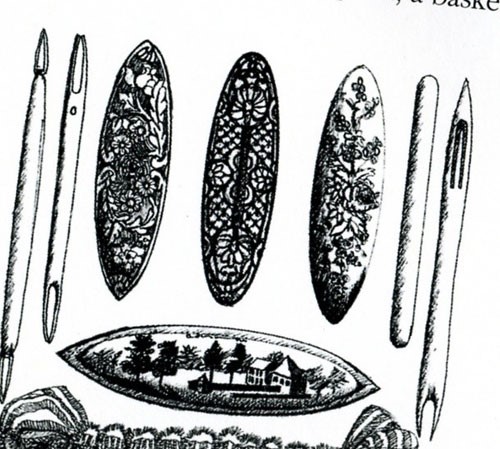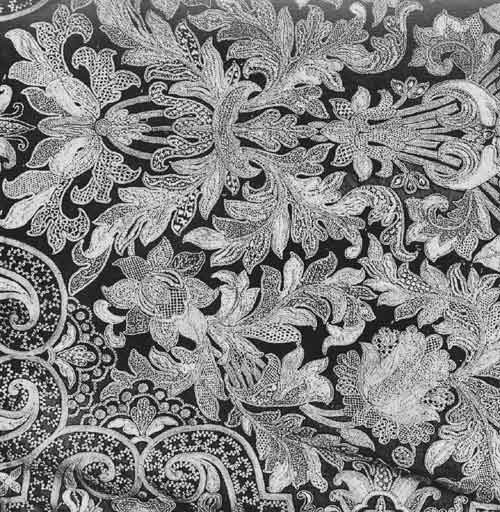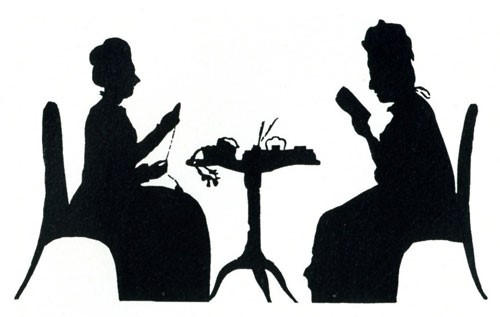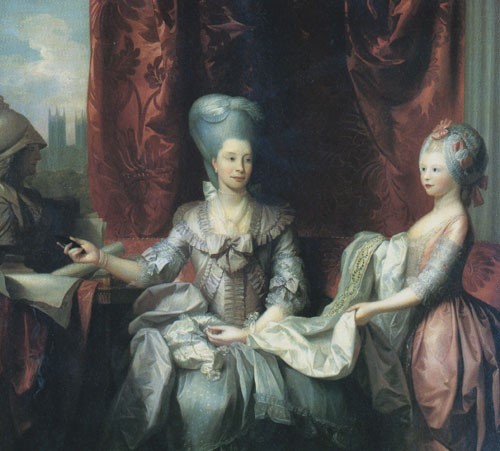Fringer
Lady Bertram in Chapter 19 of MP can console herself upon Sir Thomas’s return that
“…her own time had been irreproachably spent during his absence: she had done a great deal of carpet work, and made many yards of fringe…”
She was referring to a form of needlework known as knotting.
Look at this quote from Thomasina Beck’s book, The Embroiderers Story which explains what knotting was all about:
Unlike silk embroidery and white work, knotting did not demand close attention; it could be done by candlelight, and taken up while traveling in a coach or at a social gathering, where it gave a nice impression of diligence.
The shuttles were enchantingly decorated

and in action they showed off the hands as elegantly as a fan.
A pert letter from a pretty young thing of eighteen to The Spectator (14th November 1712) suggested that gentlemen should take up knotting because it shows off a white hand and a diamond ring to great advantage.
According to Boswell Dr Johnson tried once for his amusement to knot but soon found it beyond him. Had he persevered he would soon have acquired the knack of flicking the shuttle rhythmically to form a series of knots in the thread, which could then be sewn down, either in outline or to fill in the motifs of a design.

(Here is an illustration of knotting used in this manner-Ed.)
The size of the knots depended on the thickness of the thread wound in the shuttle, tightly twisted wool or silk, linen or string could all be knotted, the finest trimmings resembling minute, loosely strung seed pearls and the thickest chunky beads.
Here is a silhouette of Mrs. Delaney knotting: note her shuttle. She was one of the best-known exponents of the art. Lady Llandover her great grand niece, in her collection of Mrs. Delaney’s correspondence remarked that Mrs. Delaney and her sister Anne Dawes used their shuttles for relaxation and that Mrs. Delaney left after her death copious quantities of knotted trimmings:
the produce of tea table leisure hours
Pages 76-8

Therle Hughes in her book English Domestic Needlework tells us a little more about the finished product of knotting:
Princess Amelia. daughter of George II did some of this work, (bed hangings embellished with knotting-Ed.) using two shades of buff-grey knotted linen threads applied to the surface of the soft brown linen fabric to work out a big formalized flower pattern.
Various forms of knotting were popular to fill restless moments, worked with a shuttle like modern day tatting and producing a kind or cord or gimp.
In this bedhanging (at Ewhurst Park-Ed.) the leaf and flower outlines are filled with the knotty lines with assertive effect, suggesting the coral that the period adored
Page 125
JA knew how to knot: see her comments made in two of her letters:
Whilst my mother and Mr. Lyford were together I went to Mrs. Ryder’s and bought what I intended to buy, but not in much perfection. There were no narrow braces for children and scarcely any notting silk; but Miss Wood, as usual, is going to town very soon, and will lay in a fresh stock.
Letter to Cassandra 27th October, 1798
And this one from 21st January, 1799:
Our own particular little brother got a place in the coach last night, and is now, I suppose, in town. I have no objection at all to your buying our gowns there, as your imagination has pictured to you exactly such a one as is necessary to make me happy. You quite abash me by your progress in notting, for I am still without silk. You must get me some in town or in Canterbury; it should be finer than yours.
Here is a portrait by Benjamin West, the noted American artist, and a favourite of George III, (and of JA’s!) of Queen Charlotte and her daughter the Princess Royal, painted in 1776.

The Queen is shown knotting threads with a shuttle in her left hand. On the Queen’s lap are her bags, which hold and keep clean the thread, which is to be worked. These were often presented as gifts and were prettily ornamented as you can, hopefully, see.
How typical of JA to give poor, soporific Lady Bertram an occupation which, though elegant, could be performed sitting down and did not require a great deal of mental input.
